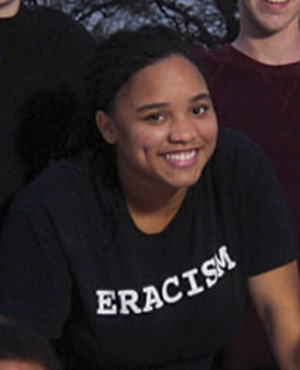Remember the past to inspire the future
Published April 30, 2014
“First they came for the Communists, and I didn’t speak out because I wasn’t a Communist.
Then they came for the trade unionists, and I didn’t speak out because I wasn’t a trade unionist.
Then they came for the Jews, and I didn’t speak out because I wasn’t a Jew.
Then they came for me, and there was no one left to speak out for me.”
– Martin Niemöller
I used to hear the word “genocide” and think about a large number of people being killed. I’d feel sorry about it but would never truly identify with the horror. Growing up, I didn’t know much about the Holocaust or Yom HaShoah. That changed when I became a member of Cultural Leadership, a yearlong social justice program for St. Louis area teens.
I was finally able to realize both the pain and the number of all those who were murdered. Since then, I have learned the importance of remembering and learning.
During my Cultural Leadership year, we traveled to Washington, where we visited the U.S. Holocaust Memorial Museum. It reduced me to tears. Looking at the artifacts in the museum made me feel as if I had stepped into life 80 years ago. Pictures and clothing made the experience all the more intimate, as if I’d known these people. You can only really begin to understand the scope of the Holocaust by trying to interact with memories of people. Feeling as if I knew these people made me feel veryemotional, especially at the end of the tour when we were shown videos of camps being liberated. Survivors cried tears of joy for their freedom, and sadness for their lost loved ones. You could recognize the shock and fear in the faces of the liberating soldiers.
It was here with my friends and classmates that I also found a connection between black and Jewish history. I realized how big a role Jewish people played in helping blacks during the Civil Rights Movement. I began to appreciate how similar our experiences were. For instance, while at the museum, we saw images of signs on buildings and benches labeled “No Jews.” This shocked me, because I didn’t know that in the period before the death camps, Jews were treated very similar to how blacks were in 1960s America.
Cultural Leadership has taught me so many things, so much that I’m not sure that I could mention everything. But I can honestly say that it’s the best thing that’s ever happened to me. My classmates and I are spread throughout the community, all with different backgrounds. And we are all able to speak and influence different audiences.
With these skills, we can educate people to learn from our ancestors: their struggles, successes, and mistakes — we will bear witness. Together, we can work to prevent history from repeating itself, while creating a better world for ourselves and for generations to come.
On the wall at the Freedom Sisters Museum in Memphis, Tenn., I found a quotation that read, “Though we march to the rhythm of our time, our mission is timeless.”
History repeats itself, the saying goes, and we must be aware of our past to prevent mistakes in the future.
I have learned that in every conflict there is always a group fighting for what is right and for the betterment of those mistreated. I will be in the group that fights for what’s right.
First they came for a young Jewish girl who they hated because of her religion. And I spoke out because she was human.
Then they came for a teenage black boy who they hated only because of his skin color. And we spoke up because he was human.
Then they came for a homosexual white man who they hated only because of his orientation. And we spoke up because he was a human.
Then they came for me, and I was saved because we were united.















